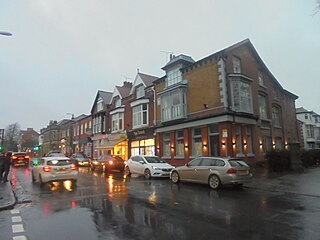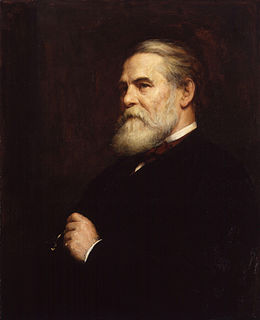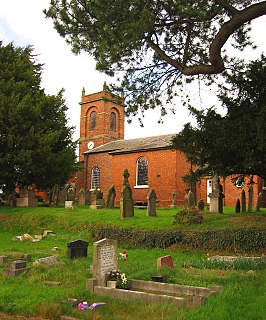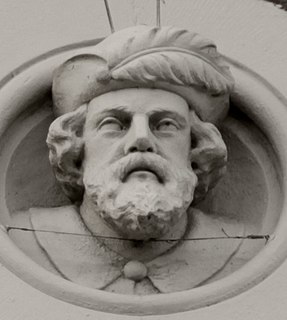
William Butterfield was a Gothic Revival architect and associated with the Oxford Movement. He is noted for his use of polychromy.

Sir George Gilbert Scott, known as Sir Gilbert Scott, was a prolific English Gothic Revival architect, chiefly associated with the design, building and renovation of churches and cathedrals, although he started his career as a leading designer of workhouses. Over 800 buildings were designed or altered by him.

Boston Spa is a village and civil parish in the City of Leeds metropolitan borough in West Yorkshire, England. Situated 3 miles (5 km) south of Wetherby, Boston Spa is on the south bank of the River Wharfe which separates it from Thorp Arch. According to the 2001 census the parish had a population of 4,006 rising to 4,079 in the 2011 census.

John Loughborough Pearson was a British Gothic Revival architect renowned for his work on churches and cathedrals. Pearson revived and practised largely the art of vaulting, and acquired in it a proficiency unrivalled in his generation. He worked on at least 210 ecclesiastical buildings in England alone in a career spanning 54 years.

Sir Arthur William Blomfield was an English architect. He became president of the Architectural Association in 1861; a Fellow of the Royal Institute of British Architects in 1867 and vice-president of the RIBA in 1886. He was educated at Trinity College, Cambridge, where he read Architecture.

Ewan Christian (1814–1895) was a British architect. He is most notable for the restorations of Southwell Minster and Carlisle Cathedral, and the design of the National Portrait Gallery. He was Architect to the Ecclesiastical Commissioners from 1851 to 1895. Christian was elected A RIBA in 1840, FRIBA in 1850, RIBA President 1884–1886 and was awarded the Royal Gold Medal in 1887.

St Mary's Church is an Anglican parish church in Nantwich, Cheshire, England. The church is recorded in the National Heritage List for England as a designated Grade I listed building. It has been called the "Cathedral of South Cheshire" and it is considered by some to be one of the finest medieval churches, not only in Cheshire, but in the whole of England. The architectural writer Raymond Richards described it as "one of the great architectural treasures of Cheshire", and Alec Clifton-Taylor included it in his list of "outstanding" English parish churches.

The Church of St Mary the Virgin is in the village of Wistaston, Cheshire, England. The church is recorded in the National Heritage List for England as a designated Grade II listed building. It is an active Anglican parish church in the diocese of Chester, the archdeaconry of Macclesfield and the deanery of Nantwich.

St. Mary Roman Catholic Church, formally the Church of the Immaculate Conception of the Blessed Virgin Mary, is in the third oldest Roman Catholic parish in Detroit, Michigan. Designed by German-born Peter Dederichs and built for the formerly ethnic German parish of the 19th century, it is located at 646 Monroe Street in what is now considered the heart of the Greektown Historic District in downtown Detroit. It is often called "Old St. Mary's Church" to avoid confusion with other St. Mary's parishes: in the Redford neighborhood of Detroit, or in nearby Royal Oak, Monroe, or Wayne.

St. Mary's Catholic Church is a parish church of the Diocese of Davenport. The church is located at the corner of St. Mary's and Washburn Streets in the town of Riverside, Iowa, United States. The entire parish complex forms an historic district listed on the National Register of Historic Places as St. Mary's Parish Church Buildings. The designation includes the church building, rectory, the former church, and former school building. The former convent, which was included in the historical designation, is no longer in existence.

St Mary the Virgin's Church, Uttoxeter, commonly called simply St Mary's, is the Church of England parish church of the town of Uttoxeter. It has a 14th-century tower and spire; the nave was rebuilt in 1828 and the chancel in 1877. It is a Grade II* listed building.

St Bartholomew's Church, Armley is a parish church in the Church of England in Armley, West Yorkshire. The church is one of two Church of England churches in Armley; the other being Christ Church. Worship at St Bartholomew's is firmly rooted in the Anglo-Catholic tradition of the Church of England with a solemn mass being celebrated weekly.

The Church of St Mary the Virgin, Deane, is an Anglican parish church in Deane, Bolton, Greater Manchester, England. It is a member of Deane deanery in the archdeaconry of Bolton, diocese of Manchester. It is a Grade II* listed building.

St Mary the Virgin's Church is in centre of the village of Fawley, Buckinghamshire, England. It is an active Anglican parish church on the deanery of Wycombe, the archdeaconry of Buckingham, and the diocese of Oxford. Its benefice has been united with those of five other local churches to form the benefice of Hambleden Valley. The church is recorded in the National Heritage List for England as a designated Grade II* listed building.

William Swinden Barber FRIBA, also W. S. Barber or W. Swinden Barber, was an English Gothic Revival and Arts and Crafts architect, specialising in modest but finely furnished Anglican churches. The Barber churches often had crenellated bell-towers. He was based in Brighouse and Halifax in the West Riding of Yorkshire. At least 15 surviving examples of his work are Grade II listed buildings including his 1875 design for the Victoria Cross at Akroydon. An 1864 portrait by David Wilkie Wynfield depicts him in Romantic garb, holding a flower. He served in the Artists Rifles regiment in the 1860s alongside Wynfield and other contemporary artists.

Robert Mawer was an architectural sculptor, based in Leeds, West Yorkshire, England. He specialised in the Gothic Revival and Neoclassical styles. He created the Neoclassical keystone heads on St George's Hall, Bradford and on Moorland's House, Leeds, and was working on the keystone heads at Leeds Town Hall when he died. He was a founding member of the Mawer Group of Leeds architectural sculptors, which included his wife, Catherine Mawer, his son Charles Mawer, and his apprentices William Ingle, Matthew Taylor and Benjamin Payler, who all became sculptors with their own careers. Many of the buildings enhanced with sculpture by Robert Mawer are now listed by Historic England.

Charles Mawer (1839–1903) was an architectural sculptor, based in Leeds, West Yorkshire, England. He was the son of sculptors Robert and Catherine Mawer and the cousin of William Ingle. He was apprenticed to his father, and worked within the partnership Mawer and Ingle alongside his cousin William and his own mother between 1860 and 1871, and then ran the stone yard himself until he formed a partnership with his fellow-apprentice Benjamin Payler in 1881. Following that date, his whereabouts and death are unknown. His last major work for Mawer and Ingle was Trent Bridge, where he carved alone, following the death of William Ingle. He is noted for his work on the rebuilding of the mediaeval Church of St Michael and All Angels, Barton-le-Street, completed in 1871, where he repaired and recreated damaged and missing Romanesque carvings, and for his carving on William Swinden Barber's 1875 Church of St Matthew, Lightcliffe. Charles' last known work ornaments another Barber church: the 1880 Church of St Thomas the Apostle, Killinghall. Charles was a member of the Mawer Group of Leeds architectural sculptors, which included those mentioned above, plus Matthew Taylor.
Benjamin Burstall was a sculptor, architectural sculptor and stone carver, based in Leeds, West Riding of Yorkshire, England.

The Church of All Saints, Harlow Hill, Harrogate, North Yorkshire, England, is a grade II listed mission church, or chapel of ease, completed in 1871 on land donated by Henry Lascelles, 4th Earl of Harewood, within the parish of St Mary. It was consecrated by the Bishop of Ripon in 1871. The building was designed with a round bell tower, in Gothic Revival style, by Isaac Thomas Shutt and Alfred Hill Thompson. After some years of closure due to structural problems, as of 2014 it was being restored for use by a funeral director's company.

John Wormald Appleyard was a sculptor and monumental mason based in Leeds, West Yorkshire, England.




















